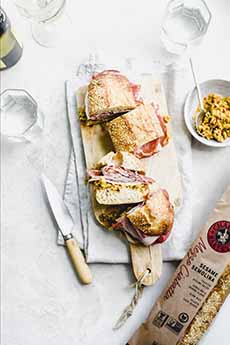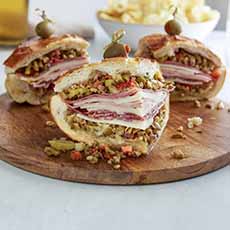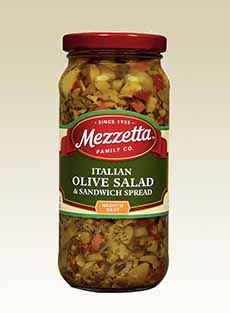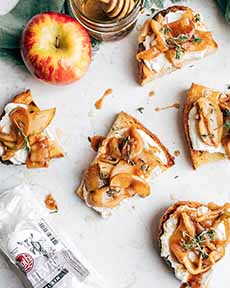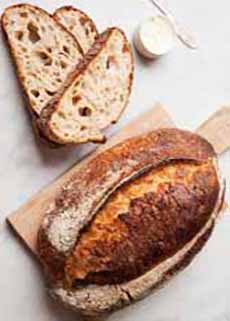|
If you’re interested in celebrating Mardi Gras (tomorrow!) but haven’t yet settled on how, here’s a tasty way: Jambalaya Arancini, a fusion of Italian arancini (rice balls) and Cajun jambalaya (a rice dish with meat and vegetables). These fried risotto balls are delicious with beer, cocktails, or wine, and a few of them can make the first course, alone or aside/atop a green salad.
While arancini are served with a broad variety of sauces, here they are served with rémoulade sauce. What is rémoulade sauce? See below.
Thanks to USA Rice for the recipe. There are many more exciting recipes on the website.
> The history of jambalaya.
> The history of rice.
> The different types of rice.
> The history of arancini is below.
RECIPE: JAMBALYA ARANCINI
These arancini are served with a remoulade sauce (photos #1 and #2).
Ingredients For The Arancini
¾ cup white long grain rice
¼ cup canola oil
4 ounces chicken thighs, diced ¼”
5 ounces smoked andouille sausage, diced ¼
¼ cup yellow onion, diced ¼
¼ cup green bell pepper, diced ¼
2 tablespoons celery, peeled, diced ¼
1 tablespoon garlic, minced
1 tablespoon jalapeño, minced
2 teaspoons Cajun seasoning blend
½ teaspoon thyme
1¼ cup chicken stock
14 ounces can diced tomato
2 teaspoons salt
1 teaspoon black pepper
To Finish
1 cup breadcrumbs
Vegetable oil, for frying
Optional: herbs for garnish, lemon wedges for serving
Ingredients For The Remoulade Sauce
1 cup mayonnaise
2 tablespoons dill pickle relish
2 tablespoons capers
1 teaspoon lemon zest
1 tablespoon lemon juice
1 teaspoon Worcestershire sauce
2 teaspoons Cajun seasoning
½ teaspoon smoked paprika
Preparation
1. MAKE the arancini mixture. Pour the canola oil into a medium saucepot over high heat. Add the chicken and andouille to the pot and sauté over high heat until browned. Remove from pot and set aside.
2. ADD the onions, bell peppers, and celery to the same pot and sauté over medium heat until the onions become translucent. Add the garlic, jalapeño, Cajun seasoning, thyme, cooked chicken thighs, and cooked andouille to the pot and continue to cook over medium heat for 30-45 seconds.
3. ADD the rice, chicken stock, and canned tomato to the pot and bring to a low simmer. Simmer over low heat for 20-30 minutes or until the rice is tender. Season with salt and pepper. Spread onto a sheet pan to cool in the refrigerator.
4. SHAPE the arancini mixture into sixteen 1-1/2-inch balls. Place the breadcrumbs in a shallow bowl. Roll the balls in the breadcrumbs and place them on a parchment-lined baking sheet. Loosely cover and refrigerate, for at least 1 hour or overnight. (If refrigerating overnight, roll in more breadcrumbs before frying.)
5. MAKE the rémoulade sauce. Fold all ingredients together in a medium mixing bowl, until fully combined. Store in the refrigerator covered until ready to use.
6. Heat 1/2 inch of vegetable oil in a large saucepan over medium heat until a deep-fry thermometer registers 350°F. Working in batches, fry the rice balls, turning, until golden brown on all sides, about 4 minutes. Remove with a slotted spoon and drain on paper towels; season with salt.
7. GARNISH as desired and serve with the rémoulade sauce.
ARANCINI HISTORY
Arancini (ah-ron-CHEE-nee]) are Italian rice balls (some call them risotto balls) that are stuffed, coated with bread crumbs, and deep-fried. They are a staple of Sicilian cuisine, and have traveled north to other areas of Italy.
Its name derives from the Sicilian plural diminutive of orange, aranciu, referring to their shape and color.
The most common fillings are al ragù or al sugo, filled with ragù, meat slow-cooked with tomato sauce); mozzarella or caciocavallo cheese, and often peas; and al burro or ô burru, filled with ham and mozzarella or besciamella (Italian-style béchamel sauce).
There are regional variations, of course, with different fillings and shapes. Arancini al ragù produced in eastern Sicily have a conical shape inspired by the volcano Mount Etna.
The most common type of arancini sold in Sicilian cafés is arancini cû sucu (it. arancini al ragù), which typically consist of meat in a tomato sauce, rice, and mozzarella or other cheese.
Many cafés also offer arancini cû burru (iarancini al burro, with butter or béchamel sauce) or specialty arancini, such as arancini chî funci (it. arancini ai Funghi, with mushrooms), arancini câ fastuca (it. arancini al pistacchio, with pistachios), or arancini â norma (it. arancini alla norma, with eggplant).
Arancini are said to have originated in 9th- or 10th-century Sicily at a time when the island was under Arab rule. (The first Arab settlement in Sicily was at Mazara, which was captured in 827. The subsequent rule of Sicily and Malta began in the 10th century. The Emirate of Sicily lasted from 831 until 1061.)
The Arabs would eat small portions of rice by making small balls with their hands and adding lamb meat. The shape was similar to a small orange, so they fittingly named it arancino.
They were, and are, a traditional food for the feast of Santa Lucia on December 13th, when bread and pasta are not eaten. Today, arancini are available year-round.
Arancini have even made it to Southeast Texas via an Italian diaspora. There, they are stuffed with a chili-seasoned filling.
Arancini Vs. Supplì
In Roman cuisine, similar fried rice balls are called supplì, most commonly filled with cheese (photo #11). In Naples, rice balls are called palle de riso (rice balls).
The history of supplì is mixed into the history of the city of Rome.
The name supplì derives from the French word “surprise,” and the food is attributed to the period when Rome was occupied and dominated by Napoleon and his army.
The story goes that the French were surprised by the mozzarella cheese hidden inside the supplì, so the name stuck.
While they are now made with beef or a bolognese sauce, the original supplì were made with chicken heart, lung, and liver.
Romans are very proud of their delicacy, believed to be one of Rome’s first “street foods,” as they were often sold by vendors on street corners.
Today, you can find supplì in pizzerias and restaurants all over Rome.
Both arancini and supplì are found in bars, restaurants, and market stalls around Italy.
They are both are breaded, deep-fried, and served with a side of marinara, but they also have some differences.
The main one is that supplì are made with arborio rice and mozzarella, while arancini are made with arborio rice, mozzarella, with the addition of beef and peas [source].
Well, O.K. then. Just serve us whatever; we’ll eat them.
And the dipping sauce?
Depending on the filling, these days they can be anything you like. The sauce can be arrabbiata sauce, aïoli (garlic mayonnaise), chimichurri, fruit sauce, marinara (photo #8), Thai peanut sauce…whatever you want to pair them with.
WHAT IS RÉMOULADE SAUCE?
Rémoulade is a variation of mayonnaise sauce, one of the five mother sauces of French cuisine—along with sauce espagnole, tomato sauce, béchamel, velouté, and hollandaise (photos #6, #7, and #10).
It is popularly served with crab cakes and other fried foods (including fried fish, French fries, fried green tomatoes, fried dill pickles…), shrimp “cocktail” (instead of red cocktail sauce), and as a sandwich spread.
In Denmark, rémoulade is eaten with french fries, hot dogs, and roast beef sandwiches [source].
According to Online Etymology Dictionary, the term rémoulade is derived from remolat, a dialect word for horseradish, the botanical name of which is Armoracia rusticana.
There may have been horseradish in earlier European recipes; horseradish is used in Louisiana-style rémoulade.
Rémoulade is similar to tartar sauce; but in the céleri rémoulade recipe, only parsley and perhaps a touch of garlic is used to flavor it.
Larousse Gastronomique shows that the full rémoulade sauce recipe—used to dress fish, seafood and other dishes—also includes chervil, chives, tarragon, capers, diced cornichons and anchovy sauce (a favorite condiment of the Romans, called garum).
Once you see how easy it is to make homemade mayonnaise—just whisk together egg yolks, lemon juice, and vegetable oil—and how much better it tastes, you may find a new kitchen favorite.
|
|
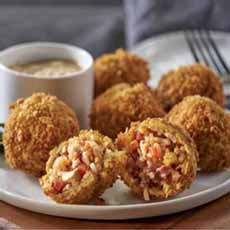
[1] Jambalaya arancini. The rice is mixed with jambalaya ingredients (photos #1 and #2 USA Rice).

[2] A close-up of the jambalaya.

[3] Some people serve arancini with lemon wedges, instead of a dipping sauce (photo © Anna Guerrero | Pexels).

[4] You can garnish the tops of the arancini, as in these snips of rosemary (photo © Gordon Ramsay Group).

[5] Instead of dipping, these arancini wear crowns of rémoulade sauce (photo © Blossom Restaurant | NYC).
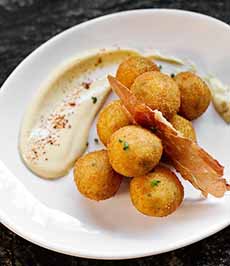
[6] This version serves arancini as a first course with a slice of flash-fried Serrano ham (photo © The Tuck Room | NYC).

[7] This jumbo arancino is topped with black truffle aïoli, pecorino cheese and pickled mushrooms (photo © Stagione | Charlotte, NC).

[8] Arancini are often served with marinara sauce (photo © Clark Douglas | Unsplash).

[9] A snack of arancini, a bit of green salad, a side of olives and toasted country bread (photo © Charlie Firth | Unsplash).

[10] Remoulade sauce is a popular pairing with fried foods, but also works with most denizens of a raw bar (photo © McCormick).
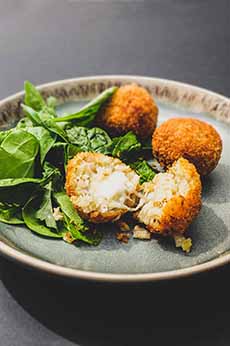
[11] Whenever you have leftover rice, make suppli. Just stick a “surprise” in the center, from a piece of cheese to any tidbid you have in the fridge or pantry. Here’s the recipe (photo © Cook Eat World).
|

















